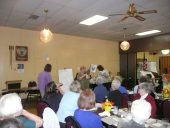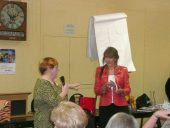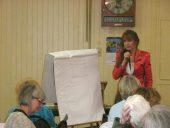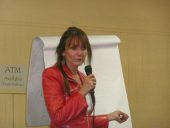Member Appreciation Event – Peggy Sagers
Darn it Out!
Amidst a wonderful celebration of Columbia River Sewing’s 25th anniversary, Peggy Sagers gave a great presentation on fit. I’ve seen her talk about her LCD theory (Length, Circumference, Depth) before so it wasn’t totally a foreign concept. I get length and circumference, but depth other than bust darts, has been harder for me to grasp. The eureka moment came for me when she demonstrated darting on the back of CRS members’ pants. All of those slanted drag lines in the back? Dart it out! Some members’ had a single dart taken at the hip to fix the problem. Some had a second dart taken at the top of the thigh. Peggy noted that if there are drag lines on the legs and only one dart is needed, it should be taken at the hip. Those drag lines have always been a problem for me when fitting myself, and I’m anxious to try her technique.
Sue Kopp and I met up during a break and decided that Peggy had given us the answer to the fitting issue that we’ve been trying to solve when creating a Wild Ginger pants pattern for Sue. Now if only Sue can remember what Peggy said about applying to the front the same changes that you make to the back…
Oh, and Peggy kept me completely engaged with her great sense of humor and her interaction with CRS model volunteers!
Jean Kennedy
Laughter and Learning
Columbia River Sewing celebrated 25 years as a chapter of the American Sewing Guild with a special program on pattern fitting. Peggy Sagers of Silhouette Patterns presented her system of fitting, solutions to common problems and answered member’s questions in an all-day program accompanied by serious information and laughter.
The program began with members asking questions and identifying problems with pattern fit while Peggy created a list of specific issues for discussion. Not surprisingly, most of the issues were related to pants fit. Next Peggy explained her LCD system for identifying fit problems and labeled each of the listed problems with their associated LCD characteristic.
In the LCD system, L stands for length. Length is always a vertical measurement, such as shoulder to bust, bust to waist, or waist to hem. C is the easiest as it is directly related to pattern size, being the circumference around the body, usually measured at the bust, waist and hip. Depth is the most difficult as it is the third dimension of body thickness. Depth is the measurement that relates to the way the garment shapes to the body, most commonly at the bust and hips. Alterations are always made in LCD order – length, circumference, depth.
The LCD system is particularly useful in diagnosing pants fitting issues. Peggy used a visual with a French curve and a measuring tape. Length is the vertical measurement from the waist to the crotch, commonly called crotch depth, circumference is the hip measurement ( to identify the amount of hip ease needed, wrap the tape measure around the hips and sit down), and the depth measurement is the length of the crotch seam, commonly called crotch length. Using the visual, Peggy showed how the measurements can stay the same but the shape of the crotch can vary greatly to fit different shaped bodies. The trick is to identify the shape of your crotch curve.
A great deal of laughter accompanied Peggy’s analysis of member’s pants fitting issues. A common problem was excess fabric below the hip in the back. Peggy showed how a horizontal dart taken in the pattern just below the hip raised the fabric and eliminated the wrinkles going down the back of the leg. We all wished we had worn a pair of our sewn pants so we could have had Peggy pin fit them for us and identify the cause of our fabric wrinkles.
Peggy showed us how to use the French curve, creating the curve that defines our preferred armhole depth or hip curve and memorizing the numbers along the curve. For example an armhole curve might be from number 14 to 23. This person could use that length on the French Curve ruler on all her patterns and know that they would fit correctly.
By the end of the day, all the problems identified at the beginning were addressed and member’s heads were bursting with new information as they politely observed each other’s fit issues. Peggy advocates fitting yourself, but most of us agreed that it would be helpful to apply her principles with a fitting partner and a three-way mirror.
For additional help with fitting issues, Peggy provides free webcasts on Monday evenings about twice a month, during which she presents information about her patterns and methods and answers specific questions from viewers. These webcasts are also available for later viewing on her website Silhouette Patterns. Several members recommended this educational opportunity. On a recent webcast, Peggy answered a question from a viewer about how to find more time to sew with the answer, “If you want to sew, go sew,” – an example of Peggy’s directness and humor.
Patricia Robertson







